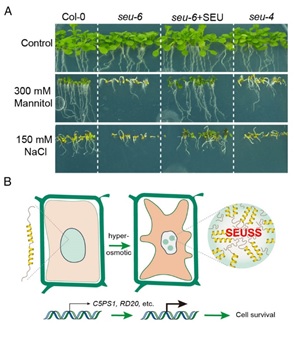A joint study by Prof. FANG Xiaofeng from Tsinghua University and Prof. LIN Rongcheng from the Institute of Botany of the Chinese Academy of Sciences (CAS) found that the transcriptional regulator SEUSS (SEU) plays a key role via its condensation during hyperosmotic stress in Arabidopsis.
This study, which explores the mechanism of SEU condensates mediating osmotic stress perception and response, was published in Nature Chemical Biology on Nov. 15.
Plants can accurately sense the wavelength, intensity, direction and period of light. This sensitivity triggers a series of signal transmission and gene expression processes that adjust growth and development patterns so as to adapt to the varying external environment.
Osmotic stress caused by high salt and drought also affects plant growth and development, and substantially reduces crop yields. However, the mechanism by which plants sense osmotic stress has been poorly understood.
In this study, the researchers discovered that SEU rapidly coalesced into liquid-like nuclear condensates upon hyperosmotic stress and the condensation was reversible.
They found that SEU harbored two intrinsically disordered regions (IDRs) in the N- and C-termini based on prediction. The scientists named these regions IDR1 and IDR2, respectively. Upon hyperosmotic treatment, IDR1 formed discrete cytoplasmic condensates whereas IDR2 did not, which demonstrated that IDR1 confers the capacity for osmotic-responsive condensation.
The researchers also revealed that SEU is essential for hyperosmotic stress tolerance since the survivability of SEU mutants was significantly lower compared to wild type and the complementation line under NaCl or mannitol treatments. At the same time, loss of SEU dramatically compromised the expression of stress-tolerance genes.
These findings uncover the critical role of biomolecular condensates of SEU in cellular stress perception and response and this mechanism helps plants resist and adapt to osmotic stress conditions.
"This study sheds new light on the significant potential for crop engineering to cope with the effects of drought and high salinity," said Prof. LIN Rongcheng, a corresponding author of the study. This work was supported by the National Natural Science Foundation of China, the Beijing Natural Science Foundation, and the Strategic Priority Research Program of CAS.

SEU is indispensable for osmotic stress tolerance. (Image by Tsinghua University and IBCAS)
Contact:
LIN Rongcheng
Institute of Botany, Chinese Academy of Sciences
Email:rclin@ibcas.ac.cn
A joint study by Prof. FANG Xiaofeng from Tsinghua University and Prof. LIN Rongcheng from the Institute of Botany of the Chinese Academy of Sciences (CAS) found that the transcriptional regulator SEUSS (SEU) plays a key role via its condensation during hyperosmotic stress in Arabidopsis.
This study, which explores the mechanism of SEU condensates mediating osmotic stress perception and response, was published in Nature Chemical Biology on Nov. 15.
Plants can accurately sense the wavelength, intensity, direction and period of light. This sensitivity triggers a series of signal transmission and gene expression processes that adjust growth and development patterns so as to adapt to the varying external environment.
Osmotic stress caused by high salt and drought also affects plant growth and development, and substantially reduces crop yields. However, the mechanism by which plants sense osmotic stress has been poorly understood.
In this study, the researchers discovered that SEU rapidly coalesced into liquid-like nuclear condensates upon hyperosmotic stress and the condensation was reversible.
They found that SEU harbored two intrinsically disordered regions (IDRs) in the N- and C-termini based on prediction. The scientists named these regions IDR1 and IDR2, respectively. Upon hyperosmotic treatment, IDR1 formed discrete cytoplasmic condensates whereas IDR2 did not, which demonstrated that IDR1 confers the capacity for osmotic-responsive condensation.
The researchers also revealed that SEU is essential for hyperosmotic stress tolerance since the survivability of SEU mutants was significantly lower compared to wild type and the complementation line under NaCl or mannitol treatments. At the same time, loss of SEU dramatically compromised the expression of stress-tolerance genes.
These findings uncover the critical role of biomolecular condensates of SEU in cellular stress perception and response and this mechanism helps plants resist and adapt to osmotic stress conditions.
"This study sheds new light on the significant potential for crop engineering to cope with the effects of drought and high salinity," said Prof. LIN Rongcheng, a corresponding author of the study. This work was supported by the National Natural Science Foundation of China, the Beijing Natural Science Foundation, and the Strategic Priority Research Program of CAS.

SEU is indispensable for osmotic stress tolerance. (Image by Tsinghua University and IBCAS)
Contact:
LIN Rongcheng
Institute of Botany, Chinese Academy of Sciences
Email:rclin@ibcas.ac.cn
